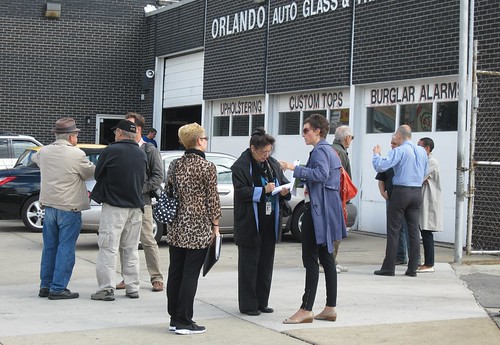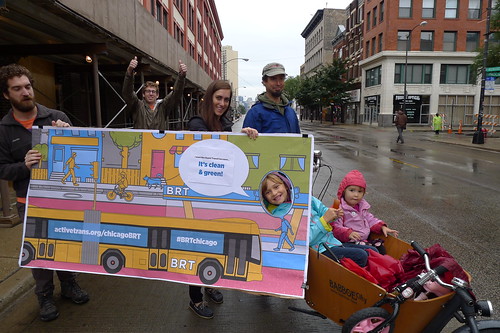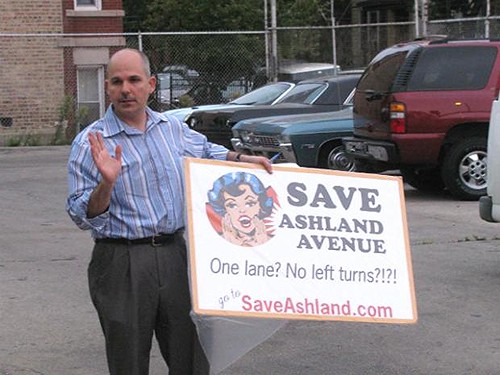When I heard that the anti-bus rapid transit group the Ashland Western Coalition was staging a photo op and interview session for the Sun-Times, I expected the worst. The NIMBY group hadn’t received any coverage from the daily papers before this, but they’d gotten plenty of flattering writeups in local publications like DNAInfo, The Gazette and Patch.
Sun-Times transportation reporter Rosalind Rossi has shown a pro-car bias in articles like this one about a public input meeting on the Milwaukee protected bike lanes, which focused on drivers’ gripes about bicyclists. Her writeup of a recent, wide-ranging sustainable transportation roundtable centered almost exclusively on her own question to Congressman Mike Quigley about whether people on bikes should be required to display license plates.
Rossi specializes in David-and-Goliath stories of citizens taking on the city bureaucracy, so in a post last Friday I fretted that all the pro-BRT quotes in her article would come from CTA staffers:
Little media attention has been given to the dozens of businesses and organizations that are official supporters of the BRT plan, or the 1,700-plus residents who have signed a petition supporting the plan or contacted their aldermen to endorse it… If Rossi follows the template used by almost all local reporters so far, the responses to the coalition members’ claims will come from CTA officials, rather than the many business and community leaders, as well as everyday Chicagoans, who support the BRT plan.
Maybe I’m flattering myself, but I’d like to think that Rossi saw my post and it encouraged her to write a more balanced article. I’m happy to report that her piece isn’t as terrible as I thought it would be.
Sure, the article includes plenty of factual errors and half-truths. Rossi reports that BRT buses will stop every quarter mile, when the stop spacing will actually be every half mile. She describes BRT bus boarding as “ground-level,” when it will really be from a raised platform at the same level as the bus floor, facilitating entry for people with disabilities and seniors, and speeding boarding and travel for everyone else. She notes that cars and trucks will share a single lane with curbside local buses, failing to mention that the locals will run far less frequently than they do today, mostly to serve those who can’t or won’t travel an extra block or two to the BRT stations.
Rossi describes the BRT opponents as North Side residents when the coalition is actually made up of businesses and organizations on the Near West Side, including several located south of Madison Street. It’s also puzzling that the reporter doesn’t mention the AWC until the second-to-last paragraph of the article.
I dropped by the interview session the coalition organized yesterday morning at Orlando Glass and Trim, 641 North Ashland. It appears that all four of the residents quoted in the article as opposing BRT were among the dozen or so people who showed up for this pre-planned event. However, since the AWC isn’t mentioned until the end, the piece makes it seem like the opposition to BRT is coming from several different directions instead of just one noisy NIMBY group.
That said, Rossi also gave airtime to three pro-BRT individuals, and only one of them was a CTA spokesperson. In addition to quoting coalition members kvetching that the repurposing of car lanes and prohibition of most left turns on Ashland will create conditions “worse than carmageddon,” she also talked to Lee Crandell from the Active Transportation, who serves as a voice of reason.
“People say removing a traffic lane or prohibiting left turns will cause a traffic nightmare,” Crandell said. “A number of cities have done more transformation to their streets than this and none of the doomsday scenarios have come true.” He gave the example of a 2011 L.A. highway closure that was predicted to create vehicular mayhem but instead went smoothly.
Rossi also spoke with Matt Nardella, owner of the architecture firm Moss Design, an official supporter of the BRT plan, who pointed out that BRT will be good for businesses’ bottom line. “[By] making the street less car-oriented, you will make it a more hospitable place for pedestrians,” he told the reporter. “By making the street more hospitable, the more likely you are to improve the retail climate on the street.’’
Granted, Rossi didn’t interview any of the hundreds of everyday citizens who have endorsed BRT, let alone actually talk to someone waiting for or riding the grindingly slow, 8.7 mph #9 Ashland bus. But this article is a step in the right direction toward writing a conventional he-said/she-said treatment of the BRT story, not that that's anything to brag about.
Rossi also got the scoop on a couple of new details about the plan, which the CTA’s Joe Iacobucci confirmed are accurate. She writes that the first 5.4-mile phase of BRT between 31st Street and Cortland Street will allow northbound left turns onto expressway ramps at Armitage, Robinson and Van Buren, and southbound left turns at Congress. She also noted that the environmental assessment for the plan will be released in mid-October, a couple of weeks later than previously projected by CTA officials, followed by 30 days of public comment.
Annoyingly, AWC leader Roger Romanelli gets the last word in the article, touting the coalition’s “Modern Express Bus” counter-proposal, which would maintain the status quo for drivers, but would provide even slower service than the old 10.3 mph #X9 Ashland Express. BRT will provide 15.9 mph rush hour service, including stops, a comparable speed to driving, which is what’s needed if we want to coax people out of their cars.
BRT is “potential carmeggedon, but it’s also a huge opportunity for change in our city if we choose a different approach,’’ Romanelli told Rossi. “For such a major change, Chicago deserves a choice.’’
He’s right about that last bit. Instead of continuing to prioritize driving, so that this inefficient, destructive mode is the only way to travel fast on Ashland, we need to give Chicagoans a choice. By providing the option of speedy, reliable BRT, we’ll allow people to choose a more affordable, healthier, smarter way to get where they need to go.








